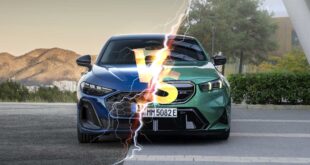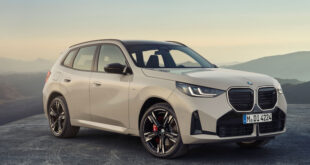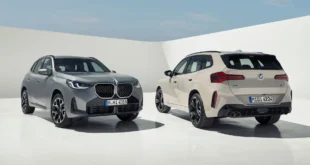- World debut No 1: BMW 3 Series Saloon
The fifth generation of the world’s most successful compact sports saloon offers even more driving dynamics, motoring comfort, and generous space inside. Even more powerful and fuel-efficient engines with both four and six cylinders, innovative assistance systems, a wide range of safety features, as well as a superior standard of equipment round off this concept for success.
- World debut No 2: the new BMW M6
The M6 is the most sophisticated and powerful BMW 6 Series Coupé there has ever been: Beneath the elegant lightweight body of this luxurious 2+2-seater lurks a thoroughbred super sports car boasting a V10 power unit, 507 hp maximum output, 520 Nm/383 lb-ft maximum torque, seven-speed SMG, and a superior chassis and suspension.
- World debut No 3: updated BMW 7 Series
Having reached the middle of its lifecycle, BMW’s most successful luxury saloon is being updated by discreet refinement in design, even more powerful and economical engines with both six and eight cylinders, as well as an even wider range of standard features.
- World debut No 4: the BMW 130i
Developing maximum output of 190 kW/258 hp, the new top-of- the-range model in BMW’s compact class is certainly the ultimate driving machine in its segment. The new striahgt-six power unit develops maximum torque of 300 Nm/221 lb-ft, accelerating the 130i from a standstill to 100 km/h in 6.2 seconds. Top speed is limited electronically to 250 km/h or 155 mph.
- Making its European debut: the 5 Series with all-wheel drive and new engines
Boasting BMW’s intelligent xDrive all-wheel-drive system as well as the new six-cylinder petrol engines, the BMW 5 Series is more attractive than ever before. All-wheel drive in the 525ix and 530ix, featuring an electronically controlled multiple-plate clutch, consistently ensures an optimum flow of power between the two axles. The new engines in the 523i, 525i and 530i are more powerful, more fuel-efficient and lighter than their predecessors, setting new standards in engine construction.
World debut No 1: the new 3 Series Saloon
The presentation of the fifth generation of BMW’s most successful model series is one of four world debuts BMW is making in Geneva.
This compact sports saloon stands out through numerous innovations, an even higher standard of driving dynamics and motoring comfort, as well as even more generous space. The new BMW 3 Series measures 4.52 metres (178.0´´) in length (up by 49 mm/1.92´´) and is + 78 mm/3.08´´ wider as well as + 35 mm/1.38´´ longer in its wheelbase. Luggage compartment capacity, in turn, has increased to 460 litres or 16.1 cu ft.
Wide range of engines
The six-cylinder petrol engines in BMW’s new engine family featuring numerous innovations are making their debut this spring in the 1, 3, 5, and 7 Series. The new straight-six boasting BMW VALVETRONIC is more powerful, more fuel-efficient and lighter than its predecessor, even ranking as the lightest six-cylinder in its class.
With maximum output of190 kW/258 hp and peak torque of 300 Nm/ 221 lb-ft, the BMW 330i accelerates from 0–100 km/h in just 6.3 seconds, while taking a mere 6.5 seconds for the interim sprint from 80–120 km/h (50–75 mph) in fourth gear. Top speed is limited to 250 km/h or 155 mph, and fuel consumption in the EU test cycle is a moderate 8.7 litres/100 km or 32.5 mpg Imp.
Entering the market at the same time, the BMW 325i (160 kW/218 hp, 250 Nm/184 lb-ft) has a top speed of 245 km/ or 152 mph and accelerates from 0–100 km/h in 7.0 seconds.
High-performance four-cylinder power units
The 2.0-litre petrol engine (110 kW/150 hp, 200 Nm/147 lb-ft) gives the 320i a top speed of 220 km/h (136 mph), together with acceleration from 0–100 km/h in just 9.0 seconds. Fuel consumption in the EU test cycle is 7.4 litres/100 km or 38.2 mpg Imp.
The BMW 320d (120 kW/163 hp, 340 Nm/251 lb-ft) is both dynamic and economical in one: Acceleration in fourth gear from 80–120 km/h comes in just 6.5 seconds, top speed is 225 km/h or 140 mph, and fuel consumption in the EU combined cycle a mere 5.7 litres/100 km (49.6 mpg Imp).
All models in the 3 Series come as standard with a six-speed manual gearbox. Six-speed automatic, in turn, is available as an option.
Chassis and suspension for even better dynamic performance
The first-class handling of BMW’s new model comes inter alia from perfect axle load distribution of 50:50. The extra-stiff double-joint aluminium front axle, together with the lightweight steel structure of the five-arm rear axle thus provides a perfect balance of driving dynamics, on the one hand, and motoring comfort, on the other.
Innovative assistance systems for extra safety on the road
Featured as standard, BMW DSC Dynamic Stability Control has been enhanced by new functions such as dry braking in the wet, start-off assistance, as well as enhanced brake readiness.
BMW’s Active Steering is available for the first time in the midrange segment, in this case in the six-cylinder models. At lower speeds Active Steering provides a more direct, at higher speeds a more indirect transmission ratio. In critical situations it serves furthermore to intervene actively in the steering, stabilising the car faster and more precisely than a normal driver ever could.
Optional ACC Active Cruise Control keeps the speed of the car, as set in advance, at the same consistent level, and even reduces speed when necessary, without requiring the driver to intervene. A radar distance sensor measures the distance to the vehicle ahead and automatically adjusts both road speed and the distance to such vehicle in specific, pre-selected stages.
Comfort, control and safety
Changing over to the new model, BMW is now introducing the iDrive control concept also in the 3 Series. Whenever the Saloon features a navigation system, complex functions can be controlled and masterminded via the Controller and the Display in the middle of the instrument panel. A further option is voice entry, allowing the driver to control numerous functions just by calling out the appropriate terms.
Fitted with no less than six airbags, the new BMW 3 Series fulfils the strictest crash regulations and requirements in the world. Intelligent lightweight engineering, in turn, serves to enhance body stiffness by 25 per cent, without adding any extra weight.
World debut No 2: the new BMW M6
The new large Coupé now being launched by BMW M GmbH is the most sophisticated and powerful 6 Series the world has ever seen: five litres capacity, 10 cylinders, 507 hp (373 kW) maximum output, 520 Nm (383 lb-ft) peak torque, and engine speeds beyond the 8,000-rpm limit.
Offering unique handling in virtually all situations, the BMW M6 ranks right at the top in the league of truly outstanding supersports. At the same time it offers all the practical driving qualities as well as the roominess and comfort of a 2+2-seater in conjunction with the luxury features of BMW’s top-end and most sophisticated cars.
Fundamental facts and figures like in motorsport
The compact, high-revving aluminium power unit with its bedplate structure, double-VANOS valve control, and individual throttle butterflies reaches engine speeds of up to 8,250 rpm, thus offering the same standards and qualities as in motorsport also borne out through specific output of more than 100 hp/ltr.
The car’s acceleration and driving dynamics are even more thrilling and convincing than the power of the engine alone: Acceleration from 0–100 km/h comes in 4.6 seconds, and the speedometer needle passes the 200 km/h mark after approximately 14 seconds. This incredible surge of power then continues all the way to the electronically imposed speed limit of 250 km/h or 155 mph.
The M6 stands out from the M5 inter alia through its shorter wheelbase, an even lower centre of gravity, and its unique chassis and suspension. Featuring BMW’s Variable M Differential Lock, EDC Electronic Damper Control and DSC with two dynamic driving programs, this outstanding suspension ensures superior active suspension at all times. And boasting brakes carried over from motorsport, the M6 comes to a halt from 100 km/h within just 36 metres or 118 feet, with stopping distance of less than 140 metres or 459 feet from 200 km/h.
Perfect concept harmony
The enormous potential of BMW’s V10 is further enhanced by harmonious interaction with the seven-speed SMG gearbox featuring Drivelogic functions and no less than 11 gearshift options as an ideal match for the outstanding suspension and lightweight body. Intentionally avoiding any kind of “wow” effects, the front and rear air dam, as well as the strongly contoured side-sills, are optimised for a perfect flow of air while at the same time underlining the overall dynamic impression of this unique sports coupe.
World debut No 3: BMW 7 Series successfully updated
Reaching the middle of its model cycle, BMW’s most successful luxury saloon so far has been enhanced for an even higher standard of driving dynamics and sporting performance, combined with a further improvement of product substance and presence.
With the exception of the V12 power unit, the BMW 7 Series comes with an entirely new range of engines as of spring 2005. All of these new engines stand out through their supreme motoring refinement, outstanding power and performance, a wide range of useful engine speed, powerful torque, and moderate fuel consumption.
The eight-cylinder petrol engines in the 750i/Li (270 kW/367 hp, 490 Nm/361 lb-ft) and in the 740i/Li (225 kW/306 hp, 390 Nm/287 lb-ft) have both been increased in size by 400 cc. The V8 diesel with its aluminium crankcase, in turn, displaces almost 500 cc more than its predecessor: Developing supreme torque of 700 Nm or 516 lb-ft, the 220 kW/300 hp 745d accelerates from 0–100 km/h in a mere 6.8 seconds.
The straight-six diesel made of aluminium (170 kW/231 hp, 520 Nm/ 383 lb-ft) gives the BMW 730d a top speed of 238 km/h while consuming just 8.2 litres/100 km in the EU composite cycle, equal to 34.4 mpg Imp.
Despite an increase in engine power by 20 kW or 27 hp, the straight-six petrol engine in the 730i/Li (190 kW/258 hp, 300 Nm/221 lb-ft) consumes 4.7 per cent less fuel than its predecessor.
Three suspension packages straight from the factory
With rear wheel track 14 mm or 0.55´´ wider than before, the enhanced aluminium chassis combines agility and sporting performance with truly outstanding motoring comfort. Apart from the series suspension, BMW also offers a special sports suspension featuring BMW Dynamic Drive anti-sway control and the top-of-the-range Adaptive Drive suspension comprising both Dynamic Drive and EDC-C Electronic Damper Control.
Refinement to the last detail
Apart from the engine compartment lid, the kidney grille, the headlights and the front air dam have all been discreetly revised and updated. Stronger, more powerful contours at the rear with a new chrome strip, new rear lights, and the modified rear air dam provide the final touch. There are also four new paintwork colours as well as three different light-alloy wheels measuring 18 and, respectively, 19 inches in diameter.
Inside the car, the feeling of space and value is further enhanced by the careful choice of materials and colours as well as three new upholstery colour options. The iDrive control concept, in turn, has been further refined for an even higher standard of user-friendliness based on optimised menu guidance and presentation.
Starting in spring 2005 xenon headlights with a headlight washing system, white direction indicator lights, and the two-stage Brake Force Display are standard on all models in the 7 Series.
World debut No 4: BMW 130i
The new top-of-the-range 130i is now rounding off the BMW 1 Series. Featuring the 3.0-litre straight-six introduced as yet another highlight in BMW’s new family of engines (190 kW/258 hp, 300 Nm/221 lb-ft), the 130i is certainly the ultimate driving machine in the compact class.
The BMW 130i accelerates from 0–100 km/h in just 6.2 seconds. Top speed is limited to 250 km/h or 155 mph, fuel consumption in the EU test cycle is a moderate 9.0 litres/100 km or 31.4 mpg Imp.
The BMW 130i appeals above all to the customer seeking to enjoy sports car performance also in the compact class – the customer looking for inconspicuous superiority combined with genuine style.
Precisely for this reason, the signs of distinction on the car versus the other BMW 1 Series are particularly discreet: Only special 17-inch rims in V-spoke design developed specifically for the 130i, chrome-plated slats in the BMW kidney grille, and the dual tailpipes with chrome-plated ends show the connoisseur that this is a particularly powerful BMW 1 Series.
The BMW 130i combines virtually all the features which make the BMW 1 Series so successful in the compact class: No other car in its segment comes with such a wide range of concept harmony made up of sporting driving characteristics and powerful style.
Making its European debut: The BMW 5 Series with four-wheel drive and new power units
BMW is presenting the 525xi and 530xi four-wheel-drive 5 Series for the first time in Europe at the Geneva Motor Show.
Benefiting from BMW xDrive, the driver has all the advantages of four-wheel drive without having to accept the disadvantages of many four-wheel-drive systems. For while conventional four-wheel drive responds only when the wheels have already started spinning, xDrive works actively even before wheel slip is able to build up, an electronically controlled multiple-plate clutch ensuring an optimum flow of power between the two axles within fractions of a second.
More power, lower weight, greater fuel efficiency: BMW’s new six-cylinder power units
Offering more power and torque within a wider useful speed range and on less fuel, the new six-cylinder petrol engines are replacing their proven predecessors. And as an additional feature, speed-related Servotronic steering is now standard on all models in the 5 Series.
The “basic“ power unit in the 523i is the 2.5-litre developing maximum output of 130 kW/177 hp and with peak torque of 230 Nm/169 lb-ft. The 523i boasts a top speed of 235 km/h or 146 mph and consumes 8.5 litres/100 km in the EU test cycle (equal to 33.2 mpg Imp). The 525i comes with BMW’s 2.5-litre power unit (160 kW/218 hp, 250 Nm/184 lb-ft), giving the car a top speed of 245 km/h or 152 mph and ensuring acceleration from 0–100 km/h in just 7.5 seconds. The top model with six cylinders, finally, is the 530i (190 kW/258 hp, 300 Nm/221 lb-ft), with top speed electronically limited to 250 km/h or 155 mph and acceleration from 0–100 km/h in just 6.5 seconds. Fuel consumption in the EU test cycle, in turn, is a mere 8.8 litres/100 km, equal to 32.1 mpg Imp.
DSC with new safety and comfort functions
The latest generation of BMW’s DSC Dynamic Stability Control in the 5 Series with xDrive incorporates new functions such as the Start-Off Assistant, Brake Standby, as well as Dry Braking in the wet, Fading compensation, as well as Soft-Stop and Hill Descent Control ensuring an even higher standard of safety and comfort.
BMW Trailer Stability Control in the 5 Series with xDrive serves to re-stabilise the car and a trailer in tricky situations: Via DSC, the system recognises critical driving conditions and applies brake forces individually as required on all wheels, without requiring any intervention on the part of the driver. The car thus acts against any rotational movement of the trailer and the car and trailer line-up as a whole is re-stabilised accordingly.
BMW Individual 3 Series at the Geneva Motor Show
BMW M is proudly presenting a show car based on the BMW 330i at the Geneva Motor Show, thus providing an outlook at the options for customising the new model generation. The wide range of BMW 3 Series Individual features comprises, inter alia, six different paintwork options and leather colours, four different kinds of interior trim, as well as additional extras such as steering wheels with wood inlays and specific door entry strips.
A further new development, BMW’s SunReflective Technology, serves as of September 2005 to reduce the heat building up on the leather seats in the convertible model otherwise caused by direct sunglare. This special feature offered by BMW Individual for the first time in the world car market enables the leather to maintain its natural qualities by reflecting sunlight in the invisible wave band.
Source – BMW AG
 BMW.SG | BMW Singapore Owners Community The Ultimate BMW Community – Established Since 2001
BMW.SG | BMW Singapore Owners Community The Ultimate BMW Community – Established Since 2001













